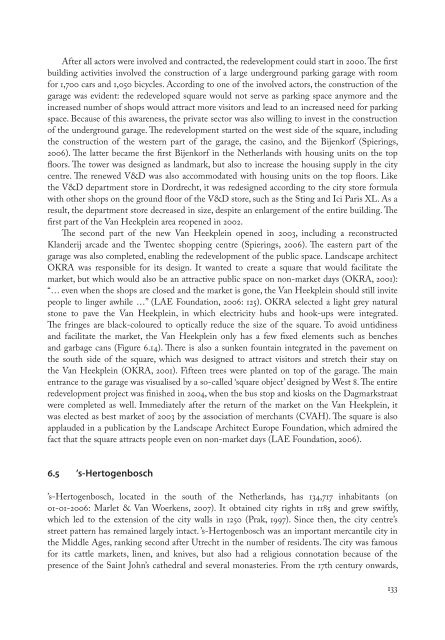Changing public space
Changing public space
Changing public space
You also want an ePaper? Increase the reach of your titles
YUMPU automatically turns print PDFs into web optimized ePapers that Google loves.
After all actors were involved and contracted, the redevelopment could start in 2000. The first<br />
building activities involved the construction of a large underground parking garage with room<br />
for 1,700 cars and 1,050 bicycles. According to one of the involved actors, the construction of the<br />
garage was evident: the redeveloped square would not serve as parking <strong>space</strong> anymore and the<br />
increased number of shops would attract more visitors and lead to an increased need for parking<br />
<strong>space</strong>. Because of this awareness, the private sector was also willing to invest in the construction<br />
of the underground garage. The redevelopment started on the west side of the square, including<br />
the construction of the western part of the garage, the casino, and the Bijenkorf (Spierings,<br />
2006). The latter became the first Bijenkorf in the Netherlands with housing units on the top<br />
floors. The tower was designed as landmark, but also to increase the housing supply in the city<br />
centre. The renewed V&D was also accommodated with housing units on the top floors. Like<br />
the V&D department store in Dordrecht, it was redesigned according to the city store formula<br />
with other shops on the ground floor of the V&D store, such as the Sting and Ici Paris XL. As a<br />
result, the department store decreased in size, despite an enlargement of the entire building. The<br />
first part of the Van Heekplein area reopened in 2002.<br />
The second part of the new Van Heekplein opened in 2003, including a reconstructed<br />
Klanderij arcade and the Twentec shopping centre (Spierings, 2006). The eastern part of the<br />
garage was also completed, enabling the redevelopment of the <strong>public</strong> <strong>space</strong>. Landscape architect<br />
OKRA was responsible for its design. It wanted to create a square that would facilitate the<br />
market, but which would also be an attractive <strong>public</strong> <strong>space</strong> on non-market days (OKRA, 2001):<br />
“… even when the shops are closed and the market is gone, the Van Heekplein should still invite<br />
people to linger awhile …” (LAE Foundation, 2006: 125). OKRA selected a light grey natural<br />
stone to pave the Van Heekplein, in which electricity hubs and hook-ups were integrated.<br />
The fringes are black-coloured to optically reduce the size of the square. To avoid untidiness<br />
and facilitate the market, the Van Heekplein only has a few fixed elements such as benches<br />
and garbage cans (Figure 6.14). There is also a sunken fountain integrated in the pavement on<br />
the south side of the square, which was designed to attract visitors and stretch their stay on<br />
the Van Heekplein (OKRA, 2001). Fifteen trees were planted on top of the garage. The main<br />
entrance to the garage was visualised by a so-called ‘square object’ designed by West 8. The entire<br />
redevelopment project was finished in 2004, when the bus stop and kiosks on the Dagmarkstraat<br />
were completed as well. Immediately after the return of the market on the Van Heekplein, it<br />
was elected as best market of 2003 by the association of merchants (CVAH). The square is also<br />
applauded in a <strong>public</strong>ation by the Landscape Architect Europe Foundation, which admired the<br />
fact that the square attracts people even on non-market days (LAE Foundation, 2006).<br />
6.5 ’s-Hertogenbosch<br />
’s-Hertogenbosch, located in the south of the Netherlands, has 134,717 inhabitants (on<br />
01-01-2006: Marlet & Van Woerkens, 2007). It obtained city rights in 1185 and grew swiftly,<br />
which led to the extension of the city walls in 1250 (Prak, 1997). Since then, the city centre’s<br />
street pattern has remained largely intact. ’s-Hertogenbosch was an important mercantile city in<br />
the Middle Ages, ranking second after Utrecht in the number of residents. The city was famous<br />
for its cattle markets, linen, and knives, but also had a religious connotation because of the<br />
presence of the Saint John’s cathedral and several monasteries. From the 17th century onwards,<br />
133




